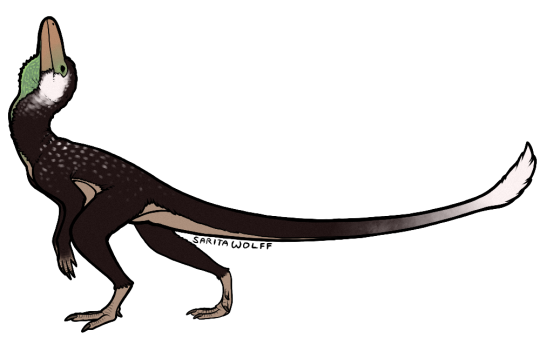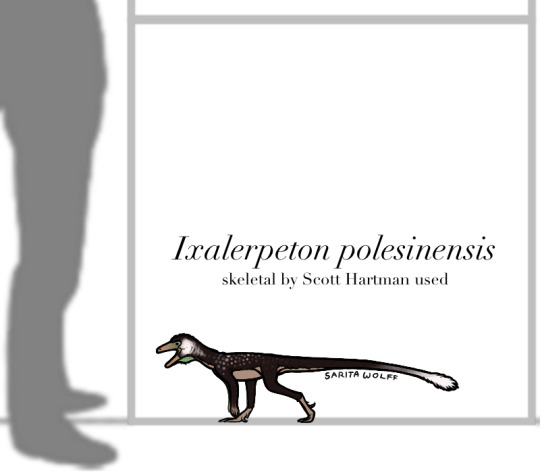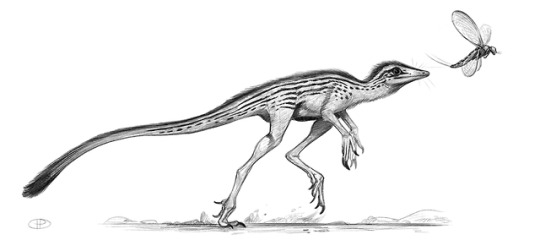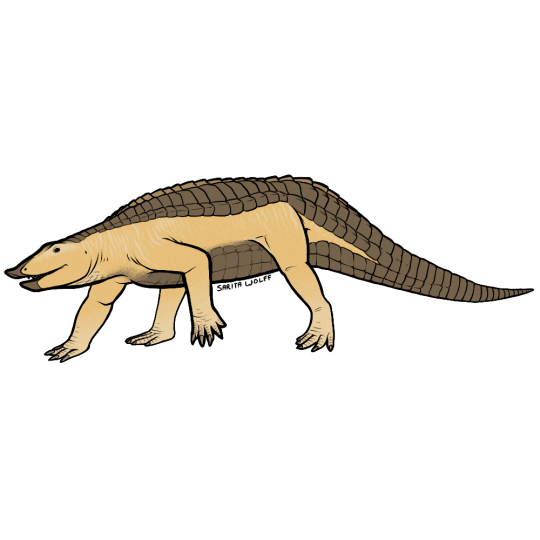#dinosauromorph
Explore tagged Tumblr posts
Text
Results from yesterday’s flocking paleostream

yesterday was SO FUCKING GOOD!!!! We did cameroceras,

Thalassotitan,

Ctenosauriscus, (he has blimd eye)

And the teeny tiny mouse lizard, Saltopus
also I have escaped the vat of hammers and am nom stuck under your floors :3
#paleoart#lmao#art#paleontology#i am in your walls#vat of hammers#inside joke#paleoblr#paleostream#flocking#flocking paleostream#what the flock#:3#cameroceras#thalassotitan#Ctenosauriscus#Saltopus#dinosauromorph#poposauroid#poposaur#pseudosuchia#nautiloid#mosasaur#lizard#rodent#insect#sciart#artists on tumblr
94 notes
·
View notes
Text
I have made a thing
yep, it includes all birds and no pterosaurs. I say Dinosauromorph, after all.
38 notes
·
View notes
Text
Gondwanax paraisensis Müller, 2024 (new genus and species)

(Type femur [thigh bone] of Gondwanax paraisensis, from Müller, 2024)
Meaning of name: Gondwanax = Gondwana king [in Greek]; paraisensis = from Paraíso do Sul
Age: Middle–Late Triassic (Ladinian���Carnian)
Where found: Santa Maria Formation, Rio Grande do Sul, Brazil
How much is known: A right femur (thigh bone), along with several vertebrae and a partial pelvis from the same site. It is unknown whether the other bones belonged to the same individual as the femur.
Notes: Gondwanax was a silesaurid, a group of probably quadrupedal Triassic reptiles that often had adaptations for herbivory (though there is evidence that they also ate insects). Until recently, silesaurids were generally considered to be close relatives of dinosaurs instead of dinosaurs themselves, and I previously excluded them from coverage on this blog. However, multiple recent analyses have suggested that they might in fact be true dinosaurs, specifically early members of Ornithischia ("bird-hipped" dinosaurs), so from here on out I will tentatively include them within this blog's purview. In fact, some of those studies have found that most "silesaurids" may not have formed a unique evolutionary group, but instead a series of lineages with some being more closely related to later ornithischians than others.
Regardless of whether it is a true dinosaur, Gondwanax is one of the oldest known dinosauromorphs (the group containing dinosaurs and their closest relatives). Compared to other dinosauromorphs of similar age, Gondwanax more closely resembles later dinosaurs in having three hip vertebrae (whereas dinosaurs ancestrally appear to have had only two). It is unusual among dinosauromorphs in having a very small fourth trochanter, a attachment point on the femur for muscles that pull the hindlimb backward.

(Schematic skeletal of Gondwanax paraisensis, with preserved bones in orange, from Müller, 2024)
Reference: Müller, R.T. 2024. A new "silesaurid" from the oldest dinosauromorph-bearing beds of South America provides insights into the early evolution of bird-line archosaurs. Gondwana Research advance online publication. doi: 10.1016/j.gr.2024.09.007
#Palaeoblr#Dinosaurs#Gondwanax#Middle Triassic#Late Triassic#South America#Ornithischia#2024#Extinct
84 notes
·
View notes
Text

DINOVEMBER 1/13: Gondwanax paraisensis
Hello everyone! I'm doing Dinovember again this year, but a little differently. I'll only be doing 3 drawings a week (ish) in order to pace myself, as in past years going the full 30 hasn't worked for me. As per usual, I'll be following my own list which is sorted oldest-youngest, with the focus this year being on new discoveries.
Talking of new discoveries, Gondwanax was only described in September this year from a femur (and other potentially assignable scraps) found in Brazil's Santa Maria formation. Gondwanax was one of the oldest known dinosauromorphs at 240Ma-230Ma, rivalling animals like Nyasasaurus, the closely related Asilisaurus from Tanzania and furthering our knowledge of the origins of dinosauria.
Gondwanax has been identified as a silesaur, a group of primarily herbivorous archosaurs which it looks increasingly like are actually the long sort-after Triassic representatives of the ornithischian dinosaurs. The phylogeny of Gondwanax published in it's description supports this, placing it and the rest of "silesauridae" as grading from basal dinosauria into crown ornithischia.
#Gondwanax#triassic#dinosaurs#palaeontology#palaeostuff#palaeoblr#paleoart#paleontology#palaeoart#dinovember#dinovember 2024#anthem posts#anthems art#silesaur#n class
43 notes
·
View notes
Text

#Archovember Day 26 - Ixalerpeton polesinensis
The Triassic lagerpetids were once thought to be early dinosauromorphs, but recent fossil evidence suggest that they were actually pterosauromorphs… either closely related to pterosaurs or even ancestral to them! Ixalerpeton polesinensis was a lagerpetid from Late Triassic Brazil, a locale that would eventually become a hotspot for pterosaurs. Like other lagerpetids, it had long hind legs with well-developed muscles, but it lacked the neural spines that suggest hopping locomotion as in Lagerpeton. It was small and agile, likely using its long legs to chase and leap after insects.

In the Upper Santa Maria Formation, Ixalerpeton would have had to watch out for large predatory pseudosuchians like Rauisuchus and herrerasaurids like Staurikosaurus and Gnathovorax. It also lived alongside early aetosaurs Aetobarbakinoides and Aetosauroides, silesaurs like Amanasaurus, and basal sauropodomorphs Buriolestes and Saturnalia. There were also a variety of cynodonts, like Gomphodontosuchus and Prozostrodon, and the temnospondyl amphibian Compsocerops.
#my art#SaritaDrawsPalaeo#Ixalerpeton polesinensis#Ixalerpeton#lagerpetid#pterosauromorphs#archosaurs#archosauromorphs#reptiles#Archovember#Archovember2023
19 notes
·
View notes
Text


Lagerpetidae
... is a family of basalavemetatarsalians. Though traditionally considered the earliest-diverging dinosauromorphs (reptiles closer to dinosaurs than to pterosaurs), fossils described in 2020 suggest that lagerpetids may instead be pterosauromorphs (closer to pterosaurs). Lagerpetid fossils are known from the Late Triassic of Argentina, Arizona, Brazil, Madagascar, New Mexico, and Texas. They were typically small, although some lagerpetids, like Dromomeron gigas and a specimen from the Santa Rosa Formation attributed to Dromomeron sp., were able to get quite large (femoral length 150–220 mm (5.9–8.7 in)). Lagerpetid fossils are rare; the most common finds are bones of the hindlimbs, which possessed a number of unique features...
Read more: Lagerpetidae - Wikipedia
illustrations: Nobu Tamura and Maurissauro
8 notes
·
View notes
Text
last final today everybody think of me and send me luck. read more is just my review session. don't really suggest opening but you know. raahhhh...
hadaen - archean - proterozoic (ediacambrian) - phanerozoic (paleozoic, mesozoic, cenozoic)
paleozoic - cambrian (explosion), ordovician (end extinction), silurian, devonian (late extinction), carboniferous, permian (end extinction)
mesozoic - triassic (end extinction) jurassic cretaceous (end extinction). of course
cenozoic - paleogene neogene quaternary
WAAHHHH.
permian - Pangaea Connected. woww synapsids evolve to large size & dominant roles! (amniotes w laterotemporal fenestrae) reptiles! ... errgggh.. Dimetrodon. Gorgonopsids. Dicynodon. Cynodon (would evolve into true mammals!).
end permian mass extinction. synapsids go OUGH! WAAAHH!!
triassic - synapsids dicynodon/cynodon rebound. first true mammals appearing.
Diapsids (fenestrae lateral + supratemporal) are evolving. like woah who is she ? Girl thats an archosaur.! diapsids who have Additional fenestrae — antorbital (in feont of orbits) and Mandibular (rear of lower jaw)! one key one to remember is the pseudosuchians who would later give rise to modern crocodilians . the other diapsid that Doesnt have additional fenestra is the. lepidosauromorph...
oldest record of dinosaur-like archosaurs from footprints ~250million years old
- small, bipedal, lacked specializations like true dinosauria (hip socket with hole)
- → dinosauromorphs (some were quadrupedal)
fuck me. ok. pterosaurs. archosaur. avemetatarsalian (ankle like a hinge rather than ball and socket). rhamphorphcynoids. wings w 1 elongated finger. first flying vertebrate yaayy
ichthyosaur - reptile. fish like lifestyle. paddle-like limbs finned tail shark like dorsal fin conical teeth etc. plesiosaur. another reptile. large test/torso, paddle limbs, rel. short tail. ok.
dinosaurs across the world from early triassic - early jurassic r fairly similar bc. pangaea.
first true sauropods (herbivorous quadrupedal saurischian) appear Late triassic with prosauropods but eventually overtake them. examples?! diplodocids and macronarians. diplodocid nipping peg-like teeth macronarians Ermm. munching teeth. less picky.
ornithischian thyreophorans appear. include ornithischian w armour e.g. stegosaurus (stegosaurus mainly known for jurassic)
I dont know where the fuck this goes. TRIASSIC END EXTINCTION!
it hit who?! Really hit the archosaurs but not the dinosaurs..?! both pseudosuchians and dinosaurs were well adapted — dinosaurs got lucky with some biological aspect that made them better able to survive the end-triassic extinction. woah!
anyway. predator wise. .... wuaw. megalosaurids and cretasaurids (theropods) but Late Jurassic had predator shift. To What? allosauroids and coelurosaurs!
allosauroids - vertebrae interlocked more rigid + proportionately longer legs
coelurosaurs - ..small. e.g. compsognathus. long series of sacral vertebrae, skinny light tail etc. would give rise to...?! Birds (first evolved late jurassic I am assuming this refers to the archaeopteryx which as found by hexley is the missing link between dinosaurs and modern birds and falls in the Avialae clade) and Tyrannosaurs! Woah!
early cretaceous has significant regional dinosaur differences. unfortunately i do not remember them! Early cretaceous is genuine fucking blur to me!! copy pasted from notes
- NA + europe: iguanodontians, ankylosaurs, brachiosaurid sauropods
- africa: dominant theropods were spinosaurs and carcharodontosaurids
- asia: coelurosaurian theropods became common, first ceratopsians evolved
erm. new theropods like spinosaurids + carcharodontosaurids, iguanodons become larger and abundant. mosasaur (reptile). bye stegosaurs (rare) hello ankylosaurs. also diplodocids go extinct. SAUROPOD DECLINE!
LATE CRETACEOUS! shit is going down.
sauropod decline but Thriving in...?! Southern supercontinent GONDWANA! but they're different from before.. 🤔 it's the Titanosaurs! most robust of All time! for example the argentinosaur the largest animal to have ever lived. also many had armour.
size and armour who could combat them... the Carcharodontosaurs! teeth like great white shark. may be an allosaurus. i think. there were also the ...! abelisaurs! last of the ceratosaurid lineage. short muzzle Short arms Small teeth this guy would go after the Smaller titanosaurs.
But what was happening in Northern supercontinent Laurasia 🤔 well the sauropod decline really hit here. so if there's an underabundance of herbivorous sauropods who is eating the fucking plants (which also differ from gondwana bc of such underabundance)
. replacing the iguanodons is the HADROSAURS! most successful herbivorous dinosaur in the northern hemisphere congratulations. two examples?! lambeosaurine which had a hollow nasal passageway in its crest (music. mating? scaring off?) and hadrosaurines which did not have that. at least some had crests just not from osteoderms. soft tissue?!
second to them is the Ankylosaurs which diverge into two main groups: tail club having ankylosaurids and No club nodosaurids. i remember bc. nodo. no dough? No money. for. ....the cl... the clu
Also second to them. marginocephalians — "fringe head" pachycephalosaurs and ceratopsians. primitive ceratopsians well known in asia but larger derived ones almost exclusive to north america.
And what is happening in laurasia Predator wise 🤔 allosaurs are doing well but they have competition: Its the Coelurosaurs! WOAHHHH!!!
tyrannasaurs, ornithomimids, maniraptorans - oviraptorosaurs + therizinosaurs + dromaeosaurs. maniraptorans had the semilunate carpal that let them sharply fold back their hands. good for u. therizinosaurs are different. theyre freaky little guys /affectionate. their claw was found first and people thought it was a claw of a sea turtle. Alas.! it was this weird dude
dinosaur rise to power was slow, steady, and pushed by misfortune of others
CRETACEOUS END EXTINCTION! grey layer at cretaceous-paleogene border found w iridium tektite and shocked quartz which r all signs of meteorite impact... Where?!
big meteor hit shore of chicxulub mexico (found by odd formation of limestone sinkholes called cenotes). shockwaves tsunamis cloud of super heated rock and dust falls causing wildfires and raised temperatures so large animals without shelter Like dinosaurs die. and then they dont get the sun for years so photosynthetic organisms and plants die. dinosaurs at the top of the food chain go goodbye :(
and despite all of this i feel so incredibly underprepared for this exam because specific details and examples haunt me. if he asks to pick a list of archosaurs i'll start biting my hand. its fine. aim for a 75. am i right guys. guys. like its multiple choice so im just praying i remember. enough. ...??? it's over for me
#💬nia.rambles#i still have to finish my essay afterward. but. exam wise. RAAAHHH#and then i am free to write whatevah i want... Woahhh..#goal is to go through all my wips/reqs before the year ends. Hah....#this will be my month. ...my last half of a month.
6 notes
·
View notes
Text

dinosauromorph
0 notes
Photo




Okayyyy, back to posting art on here!! It’s been a while, but here’s the first piece that I created for @wtf-triassic, the tiny boi dinosauromorph Lagerpeton chanarensis. This small lad hails from the Argentinian Chañares Formation, and is about 235ma old. As a dinosauromorph, Lagerpeton falls just outside the line between dinosaur and non-dinosaur, which is a super abitrary line given how similar some of these species are to “true” dinosaurs. The Chañares Formation is full of other almost-dinosaurs-but-not-quite, making it a fascinating snapshot in time of the very beginnings of the dinosaurian lineage.
As an almost-a-dinosaur, Lagerpeton was probably covered in fluffy filaments, or “protofeathers”, since based on their existence in both dinosaurs and pterosaurs these fibres were likely ancestral at least to ornithodirans, the group that includes pterosaurs, dinosaurs, and vague difficult-to-define little things like Lagerpeton.
There’s not a whole lot special about this reconstruction in particular, I used my usual process for digital painting. I did make more use of textured brushes, which are an excellent way of roughing out textures that I highly recommend experimenting with. I might make a tutorial post on that at some point, it’s something I’ve found extremely useful.
I also chose to make him spotty, since for some reason there aren’t many reconstructions of spotty dinosaurs even though spots are everywhere in the animal kingdom. #bringbackspotsinpalaeoart2020 guys, let’s get that disgustingly-clunky tag trending.
#dinosaur#dinosauromorph#lagerpeton#art#my art#palaeoart#paleoart#palaeontology#paleontology#dinosaur art#digital art#wtf-triassic#palaeoblr#brinkbackspotsinpalaeoart2020
168 notes
·
View notes
Video
youtube
A newly described proto-dino-pterosaur provides new insights into the evolution of both dinosaurs and pterosaurs.
#kongonaphon#theropod#dinosauromorph#pterosauromorph#ornithodira#avemetatarsalia#insectivore#new discovery#scicomm#science education#earth science#life science#geology#biology#paleontology#fossils#science#histology#lines of arrested growth#lagerpetidae#transitional species#transitional fossil#jurassic park#jurassic world
24 notes
·
View notes
Photo

A leggy little lagosuchus chases down its meal.
#My art#not a dinosaur#but close#lagosuchus#insect#triassic#dinosauromorph#running#fuzzy#flying#prehistoric#paleontology#paleoart#paleoillustration#illustration#Black and White#drawing
331 notes
·
View notes
Note
Who invented the dinosaur?
"Invented"?
Do you mean Evolved?
Dinosauriformes evolved Dinosaurs
Dinosauromorphs evolved Dinosauriformes
Ornithodira evolved Dinosaurormorphs
Avemetatarsalians evolved Ornithodirans
Archosaurs evolved Avemetatarsalians
I'll stop there
167 notes
·
View notes
Photo

Tarjadia and Marasuchus.
Photoshop
94 notes
·
View notes
Photo

Day 9 of my palette challenge (palettes found here) has the carnivorous sauropodomorph Buriolestes in #29, snatching up an unlucky Ixalerpeton.
111 notes
·
View notes
Text

#Archovember Day 15 - Stagonolepis robertsoni
The Late Triassic aetosaurs were heavily armoured, terrestrial, herbivorous pseudosuchians (croc-line archosaurs), somewhat similar to the dinosaurian ankylosaurs that came much later. They were very successful, being the most abundant vertebrates in some environments. They came in a variety of shapes and sizes, from the large, spike-shouldered Desmatosuchus to the flattened, neck-spiked Typothorax to the tiny Aetosaurus ferratus. Some aetosaurs had a flattened, upturned, beak-like snout similar to pigs, which they probably used to dig for roots and tubers.
Stagonolepis robertsoni had one of the most extreme shovel snouts. It lived in Late Triassic Scotland and was a mid-sized aetosaur at around 2.5 metres (8 ft) long. Like other aetosaurs, it was covered in thick osteoderms covering the full length of its body. As it was fairly slow moving, this armour would have been necessary to repel attacks from other archosaurian predators of the time. It likely uprooted plants like horsetails, ferns, and the newly arrived cycads, chewing them with the peglike teeth at the back of its mouth. Stagonolepis’ front legs also seems to be adapted for “scratch digging,” which it would have employed to break through compacted soil before rooting around with its shovel snout.

Stagonolepis robertsoni lived in a sandy desert environment, and would have shared it with a variety of odd Late Triassic animals, including other pseudosuchians like Erpetosuchus and Ornithosuchus, early dinosauromorphs like Saltopus, early pterosauromorphs like Scleromochlus, rhyncosaurs like Hyperodapedon, and lizard-like parareptiles like Leptopleuron. No large predators (other than possibly Ornithosuchus) have been found in the Lossiemouth Sandstone Formation, but there must have been Carnian-era predators (likely large pseudosuchians) in Scotland for Stagonolepis’ armour to have been necessary, and they may be out there waiting to be found.
#my art#Stagonolepis robertsoni#Stagonolepis#aetosaur#pseudosuchians#archosaurs#archosauromorphs#reptiles#Archovember#Archovember2023
9 notes
·
View notes
Photo

New Proto-Dinosaur Found in Colorado
A lanky reptile found in the Centennial State is a close cousin of early dinosaurs
What’s almost a dinosaur, but not quite? The answer, as paleontologists have come to understand, is “a silesaur!”, a non-dinosaurian dinosauromorph. I know that’s a bit of a mouthful. Let’s unpack that.
Silesaurs aren’t exactly famous in fossil circles yet. The iconic member of the group, Silesaurus, was named in 2003 and the group’s identity wasn’t fully recognized until 2010. As old as they are, dating back through the Middle and Late parts of the Triassic, they’re pretty new on the Mesozoic block. And they’re important to our understanding of how dinosaurs evolved. Silesaurs are not technically dinosaurs, but they’re close relatives that belong to the larger group which dinosaurs are nested in.
That’s why they’re called non-dinosaurian dinosauromorphs – in short, protodinos. And paleontologists Jeffrey Martz and Bryan Small have just named a new one from Colorado.
The new silesaur, known from parts of the skull and body, is named Kwanasaurus williamparkeri and lived more than 207 million years ago. Its name is a combination of Ute and Greek meaning “eagle lizard,” while the species name honors influential Triassic paleontologist Bill Parker. It’s the fourth silesaur known from North America, and the latest of 11 described so far...
Read more: https://blogs.scientificamerican.com/laelaps/new-proto-dinosaur-found-in-colorado/
13 notes
·
View notes